Have you ever wished for a single tool that could organize your tasks, track your goals, and capture your thoughts—all in one place?
Enter the bullet journal: a flexible, analog system that helps you plan your days, reflect on your progress, and unleash your creativity.
This guide will walk you through everything you need to know, including all the technicalities—spreads, logs, and more—so you can start a bullet journal for beginners or level up your existing practice.
Table of Contents
What Is a Bullet Journal?
A bullet journal (often called a “BuJo”) is a customizable organization system developed by Ryder Carroll. It combines elements of a planner, diary, to-do list, and sketchbook into one notebook.
The core idea is to use rapid logging—short, bulleted entries—to track tasks, events, and notes efficiently. You can use a bullet journal for work, school, personal goals, or even as a creative outlet.
Why Start a Bullet Journal?
- Boost productivity: Keep all your tasks, appointments, and ideas in one place—perfect for those looking for how to use a bullet journal effectively.
- Increase mindfulness: Reflect on your goals, habits, and progress.
- Reduce digital overload: Escape screens and enjoy the tactile pleasure of pen and paper, or try a digital bullet journal if you prefer.
- Get creative: Design layouts, doodle, and personalize your journal to your heart’s content, including bullet journal doodles and calligraphy.
What You Need to Start
- A notebook: Any notebook will do. Dotted or grid notebooks are popular, but you can make a bullet journal on lined paper or even create a bullet journal in OneNote, Evernote, Keynote, or on your phone or Android device.
- A pen: Choose one you enjoy writing with. For those interested in how to write neat in a bullet journal or improve your handwriting, fine-tip pens are a favorite.
- Optional supplies: Colored pens, highlighters, stickers, washi tape, and rulers for added flair. If you want to know how to decorate a bullet journal or its cover, washi tape and stickers are great starting points.
Don’t get bogged down in supplies—start simple, and add extras as you go.
The Core Components of a Bullet Journal
1. The Key
The key is your personal legend—a set of symbols that represent different types of entries. Here’s how to make a key for a bullet journal:
| Symbol | Meaning |
| – | Task |
| o | Event |
| – | Note |
| * | Priority |
| > | Migrated |
| < | Scheduled |
Place your key at the front of your journal for easy reference. Customize it to suit your needs.
2. The Index
The index is your bullet journal’s table of contents. As you fill your journal, list the page numbers and topics here, so you can easily find information later. Here’s how to make a bullet journal index:
| Page | Topic |
| 1-2 | Index |
| 3 | Key |
| 4-7 | Future Log |
| 8-9 | January Log |
Leave two to four pages at the front for your index.
3. The Future Log
The future log is where you record upcoming events, appointments, and long-term goals. This is essential for those wondering how to bullet journal for a month or plan ahead.
How to set up:
- Title a spread “Future Log.”
- Divide it into 6 or 12 sections (one per month).
- Add events, deadlines, and plans.
For a simple future log, have a look at this:-
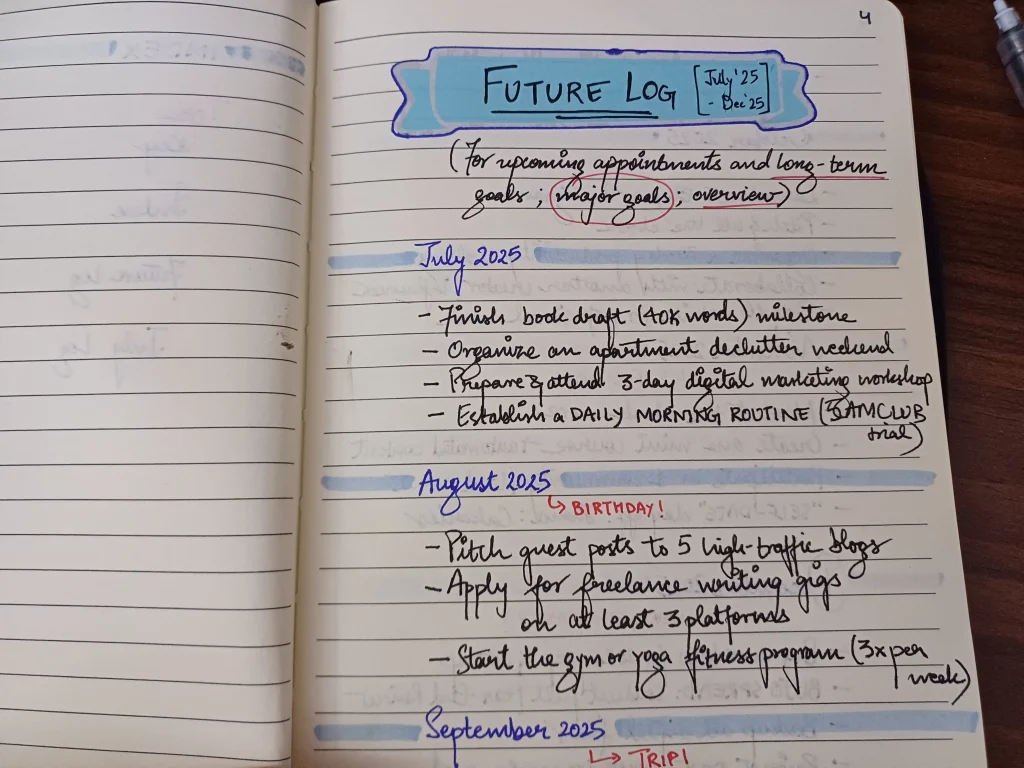
Decorate with washi tape, stickers, or bullet journal doodles if you like. For digital fans, you can create a digital bullet journal in apps like OneNote or Evernote.
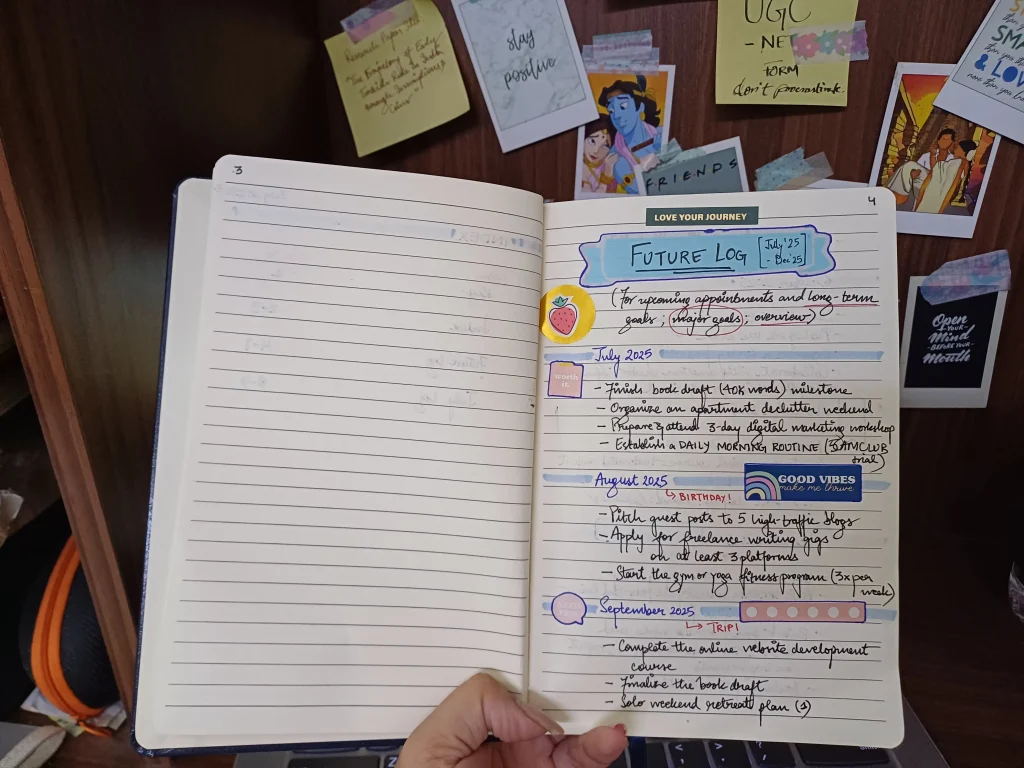
Why is a ‘future log’ spread included? To give us a breakdown of big tasks that need to be done for your dream achievements. Eventually, in a monthly log, you’d be entering the smaller steps you take each day to complete these big tasks of your future log.
Future log = overview of big tasks.
4. The Monthly Log
The monthly log gives you an overview of the month ahead. You can make your headers like:-
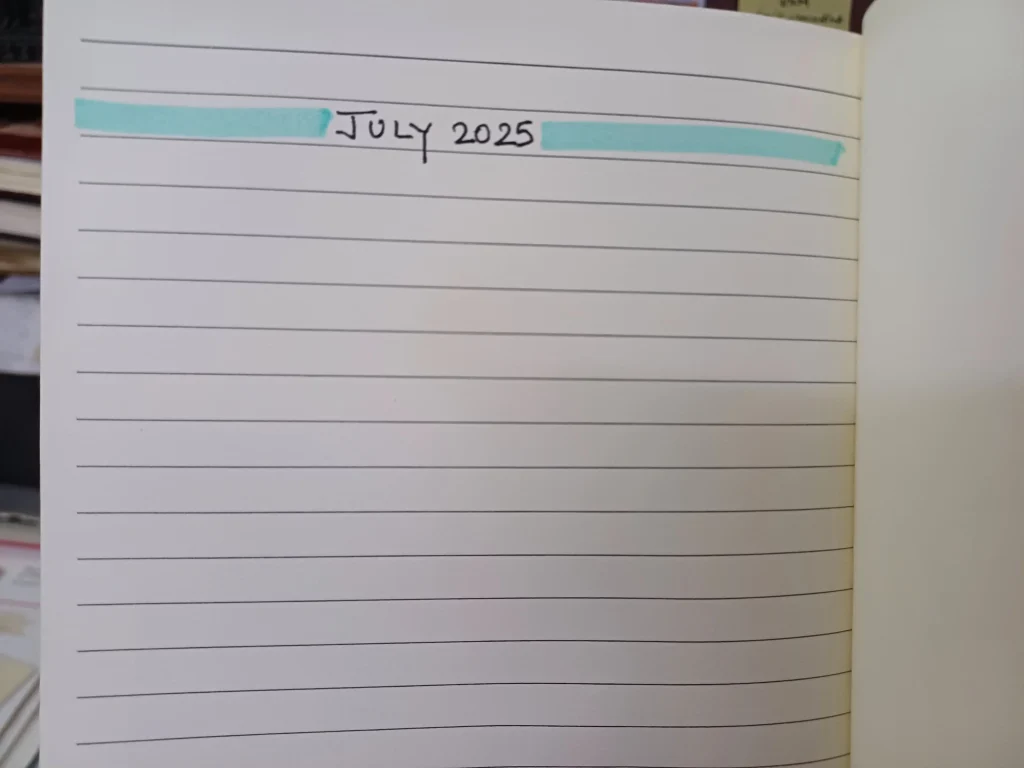
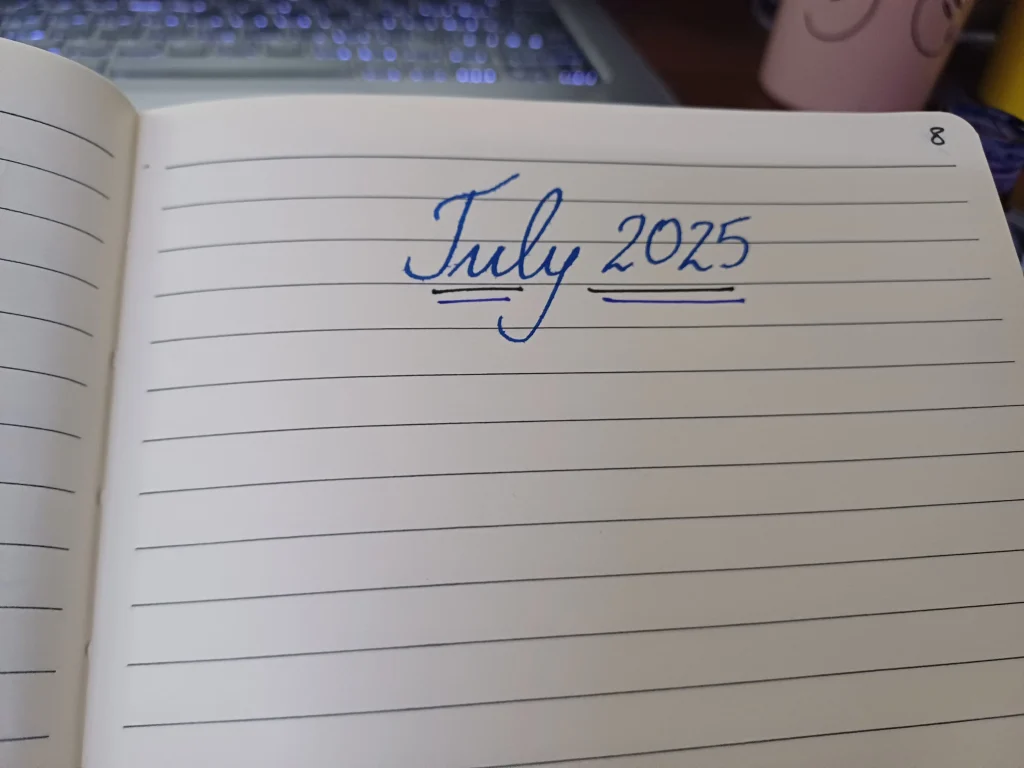
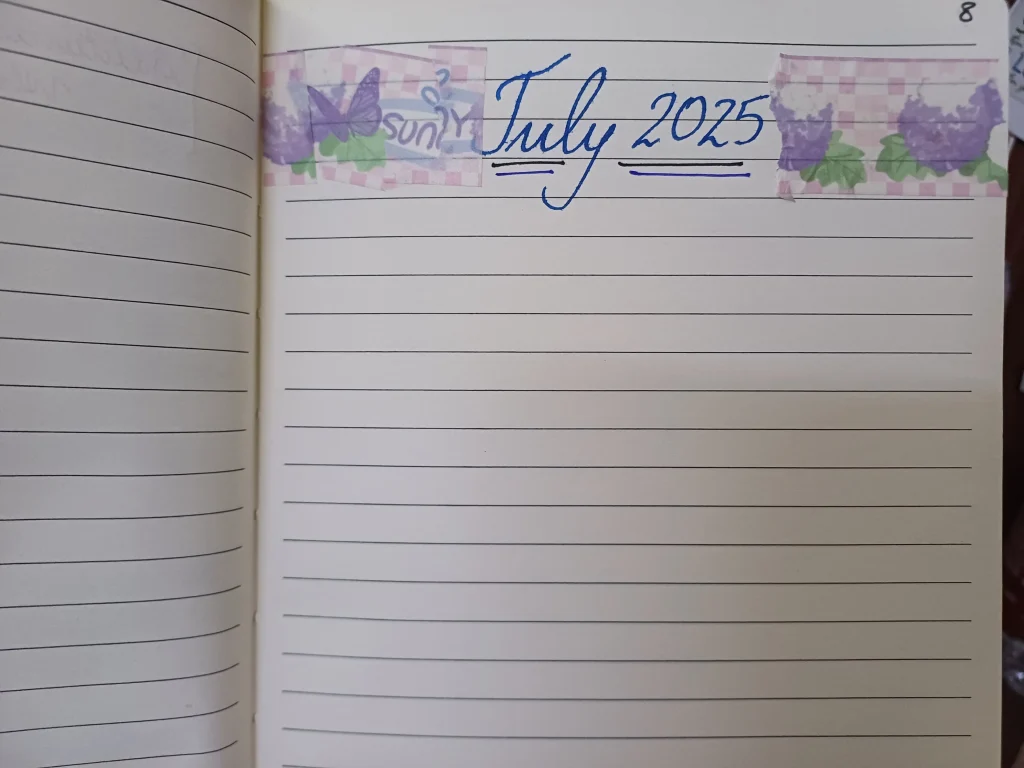
There are two common formats:
- Calendar format: List the days of the month down the side and note appointments or events. I recommend using this if you already have an established routine and want to either plan your after- work/university hours or just want to focus on getting one ‘side gig’ of yours done.
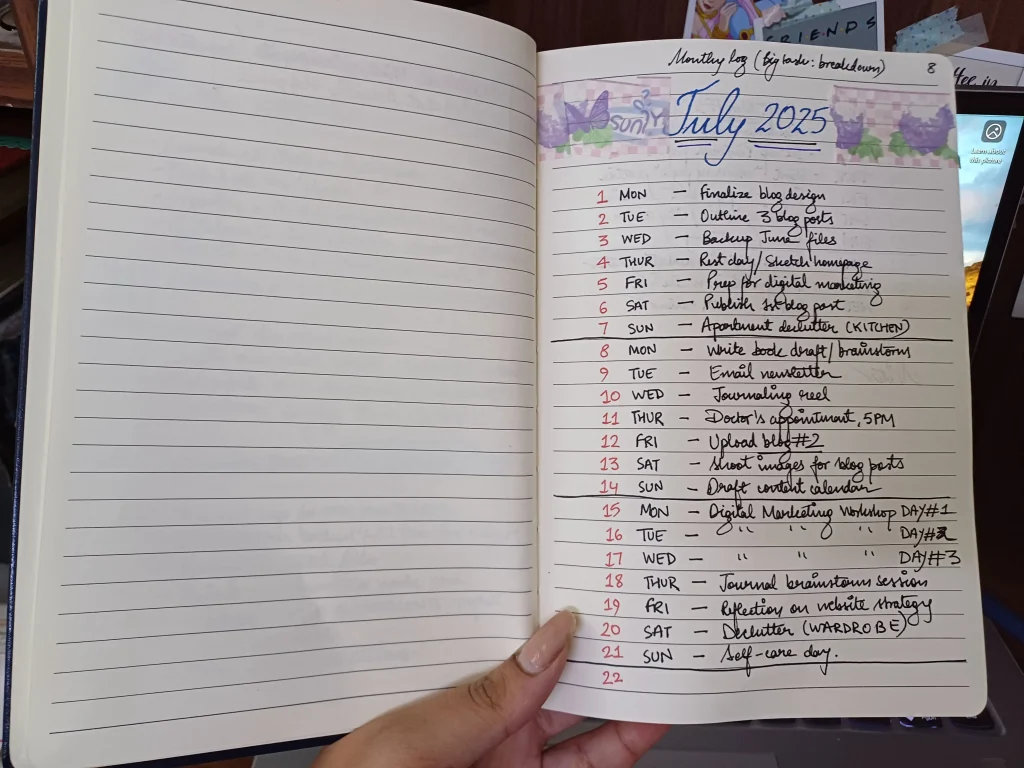
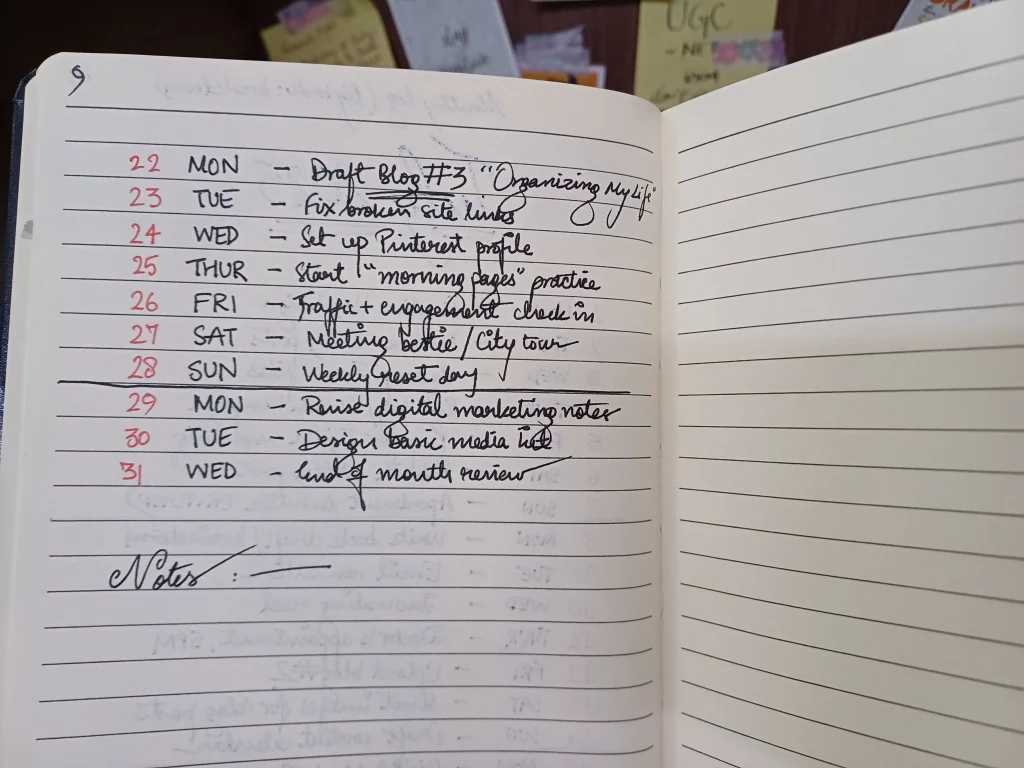
- Task list format: Create a list of tasks to accomplish during the month.
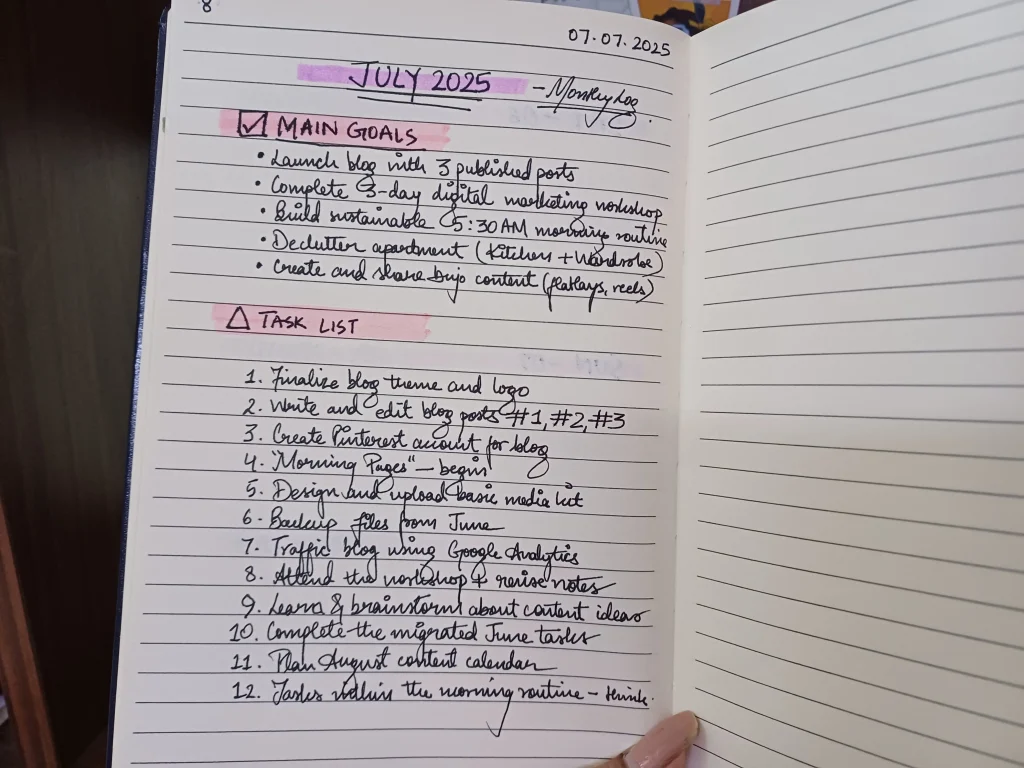
How to set up:
- Title a page with the month.
- List dates and days down the page.
- Add events and appointments.
- On the facing page, list monthly goals and tasks.
If you want to know how to draw a calendar in a bullet journal, simply use a ruler and pen to create boxes for each day.
5. The Daily Log
The daily log is where you track your day-to-day tasks, events, and notes.
How to use:
- Write today’s date.
- List tasks (- ), events (o), and notes (–).
- Mark completed tasks with an “X.”
- Migrate unfinished tasks to the next day or month with a “>.”
This is the heart of how to use a bullet journal for work, school, or personal life.
6. Collections
Collections are custom pages for anything you want to track—habit trackers, reading lists, project plans, gratitude logs, and more. If you’re curious about how to do a habit tracker in a bullet journal, simply draw a grid and mark your progress each day.
Popular collection ideas:
- Habit trackers
- Books to read
- Meal plans
- Fitness logs
- Budget trackers
- TV show tracker bullet journal
- Mood tracker bullet journal
- Project management
- Meeting notes
- Weight loss tracker
Add these to your index for easy reference.
How to Write a Bullet Journal: Step by Step Process
Step 1: Set Your Intentions
Ask yourself: What do I want from my bullet journal? Productivity, habit tracking, creative outlet, or goal achievement? This helps you decide how to layout your bullet journal.
Step 2: Set Up Your Journal
- Number your pages (if your notebook isn’t pre-numbered).
- Create your key on the first page.
- Set up your index on the next two to four pages.
- Add your future log—a spread for the next 6–12 months.
- Create your first monthly log.
- Start your daily log on the next blank page.
You can also add pages to your bullet journal as needed, or combine your bullet planner with a personal journal.
Step 3: Start Rapid Logging
Rapid logging uses short, bulleted entries to capture tasks, events, and notes. Don’t worry about perfection—just get your thoughts down quickly.
Example:
text
July 7
– Finish blog post draft
o Doctor’s appointment, 3pm
– Idea: Start a gratitude collection
Try experimenting with bullet journal banners, headers, and calligraphy for a personalized touch.
Step 4: Review and Migrate
At the end of each day, week, or month, review your logs:
- Mark completed tasks with an “X.”
- Migrate unfinished tasks to the next day or month using a “>.”
- Strike out irrelevant tasks.
- Update your index with new collections or important pages.
This process, called migration, helps you focus on what matters.
Step 5: Experiment and Customize
Your bullet journal is yours—make it work for you! Try different layouts, experiment with trackers, or add artistic touches like bullet journal doodles, banners, and creative headers. If a spread doesn’t work, change it up next month.
Tips for Bullet Journal Success
- Start simple: Begin with the basics before adding more.
- Be consistent: Set aside a few minutes each day to update your journal.
- Review regularly: Reflect on your progress and adjust as needed.
- Don’t compare: Focus on function over form, especially if you’re not artistic.
- Make it fun: Use colors, stickers, or doodles if you enjoy them.
Common Bullet Journal Mistakes (and How to Avoid Them)
- Trying to do too much at once: Start with the core modules—key, index, future log, monthly log, daily log.
- Getting stuck on aesthetics: Remember, function comes first.
- Not reviewing or migrating tasks: Regular review is essential.
- Neglecting your journal: If you miss a day (or a week), just pick up where you left off.
- Losing motivation: Learn how to keep yourself motivated to follow your bullet journal.
Sample Bullet Journal Layout
| Page | Content | Example Entry |
| 1 | Key | – Task, o Event, – Note, * Priority |
| 2-3 | Index | 4: Future Log, 8: January Log |
| 4-7 | Future Log | Jan: Doctor appointment, Feb: Vacation |
| 8-9 | January Log | 1: New Year’s party, 2: Project deadline |
| 10+ | Daily Logs | July 7: – Finish report, o Meeting at 2pm |
| 12 | Collection | Books to Read: “Atomic Habits,” “1984” |
Going Beyond: Digital and Alternative Bullet Journaling
- How to create a bullet journal in OneNote, Evernote, or on your phone: Use digital note-taking apps to mimic the bullet journal system. You can also use Trello as a bullet journal or download bullet journal printables.
- How to make a bullet journal in Keynote: Design layouts and export them to your device.
- How to bullet journal in a planner: Use a pre-made planner and adapt the bullet journal method to its structure.
- How to set up a bullet journal for school: Track assignments, deadlines, and study schedules.
- How to use a bullet journal for weight loss or project management: Create dedicated collections for goals, progress, and milestones.
Decorating and Personalizing Your Bullet Journal
- How to decorate your bullet journal cover: Use stickers, washi tape, or your own artwork.
- How to draw banners, headers, and calendars: Use a ruler and colored pens for neat, creative designs.
- How to write bullet journal calligraphy: Practice different fonts and styles for headings or quotes.
- How to decorate the first page of a project bullet journal: Add motivational quotes, doodles, or a vision board.
- How to use washi tape in a bullet journal: Mark sections, add color, or create tabs.
Also Read:
- The Story Behind the Bullet Journal: A Journey of Curiosity and Creativity
- How to Write Quotes in a Bullet Journal?
Final Thoughts
A bullet journal is more than just a planner—it’s a powerful tool for organizing your life, reflecting on your goals, and expressing your creativity.
There’s no right or wrong way to do it: start simple, experiment, and make it your own. Whether you want to know how to start a minimalist bullet journal or how to combine a bullet planner with a personal journal, the system is designed to serve you.
Let it evolve as your needs change, and don’t be afraid to make mistakes along the way.
Happy journaling!

